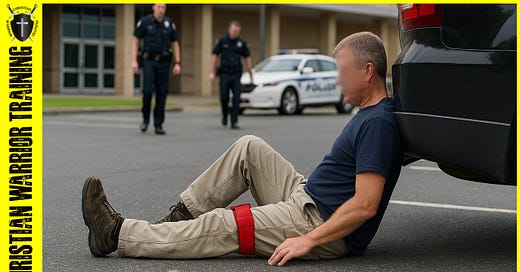A man in his 60s accidentally shot himself in the leg after working security for a church event at Camp Jordan Arena in East Ridge, Tennessee. It happened just before or after the event concluded, and the details—while tragic—are preventable. According to the East Ridge Police Department, the man was found on the ground behind his SUV, suffering from a gunshot wound to the upper leg. He had discharged his weapon while attempting to put it away.
Police immediately began lifesaving measures before Hamilton County EMS transported him to the hospital. His current condition is unknown. East Ridge PD ruled the incident an accidental discharge.
This article isn't about embarrassing anyone. It's about learning. Incidents like this destroy church security teams. Worse, if an innocent bystander had been hit, it could have destroyed the church itself.
Don’t Want To Watch the Accompanying Video? Click Below
Don’t Call It an Accident — This Was Preventable
While the official language refers to it as an "accidental discharge," it’s more accurate—and more honest—to call it a negligent discharge. Firearms don’t go off on their own. Something was done wrong, and that something can be addressed with proper training and policies.
I’ve said this many times: I’m more worried about an untrained concealed carrier walking into church with a substandard gun in a soft felt holster than I am about an active shooter. And this is exactly why.
The Prevention Plan Every Church Must Implement
1. Firearms Competency Testing
Before someone is allowed to carry a firearm to protect the congregation, they should demonstrate that they are competent with their weapon system. On my team, we require:
Safe holstering and unholstering
Reloading without prompting (we’ve seen magazines inserted backwards—yes, really)
Malfunction clearing
Field-stripping and reassembly of their firearm
If someone can't do these things without coaching, they’re not ready. This isn’t about their right to carry—it’s about their ability to carry safely around others.
2. Mandatory Firearms Qualification
A proper qualification test is a non-negotiable requirement for church security. Most churches don’t even require one. That’s a mistake.
Law enforcement qualification courses are not designed for the church environment. A police officer might need to shoot defensively at a gas station or in a grocery store. You know exactly where your incident will occur: in your sanctuary, your parking lot, your classrooms.
Your qualification course should reflect that. If you don’t have one, I’ve published a church-specific course of fire you can adopt:
▶️ Watch the Course Here
You owe it to your team—and your congregation—to run that at least once a year. Twice is better.
3. Approve Only Quality Equipment
Uncle Mike’s soft holsters should be banned. Cheap guns that can’t survive repeated training should not be allowed on duty. And even high-end firearms like Staccatos come with considerations—some models can fire if dropped on the barrel.
Every weapon and holster should be approved by your Rangemaster or lead trainer. And the criteria should include:
Full trigger guard protection
Adequate retention
Strong materials (Kydex or stiff leather only)
No gimmicks
The risk of someone shooting themselves in the groin, leg, or worse is very real—and far more common than people think.
4. Carry a Tourniquet—Always
A tourniquet could have saved this man’s life if his femoral artery had been struck. Everyone carrying a weapon should have a tourniquet on them, not in their car, not in a bag. On-body. Accessible by either hand.
Tourniquet training should be standard in your team’s annual rotation.
5. End-of-Shift Weapon Handling SOP
Negligent discharges happen most frequently during administrative handling—especially while disarming. Police departments see this in locker rooms all the time.
Church security volunteers should be instructed to leave their firearm holstered until they are home, where they can safely secure it. Disarming in the parking lot—rushing to get out of uniform or store a weapon—is an unnecessary risk.
You can take it further with a written SOP that includes:
When and where weapons may be stored
How disarming should occur
Approved storage methods for different environments
Don’t assume people will figure it out. Tell them.
We Must Learn or We Will Repeat This
To the man who was injured: we’re praying for your healing and your recovery. And we’re praying for your team. This should not have happened, but we can all use it to sharpen our readiness.
If you’re a church leader, team coordinator, or trainer—implement these five steps now. Don’t put it off. This incident could have ended much worse. The next one might.
I don’t want to see your church in my newsletter or on my YouTube channel. But if your team lacks these standards, you’re one accident away.
Stay alert. Train hard. Protect the flock.
For free resources and security team tools, visit ChristianWarriorTraining.com





Rather timely I think.
“Firearms don’t go off on their own” … ‘cepting maybe certain Sig model(s), maybe?